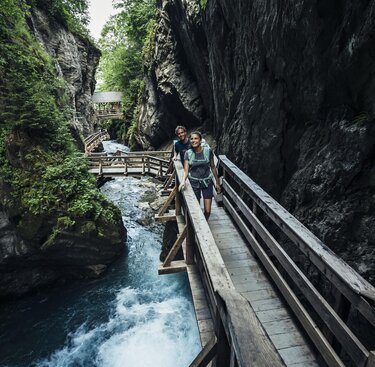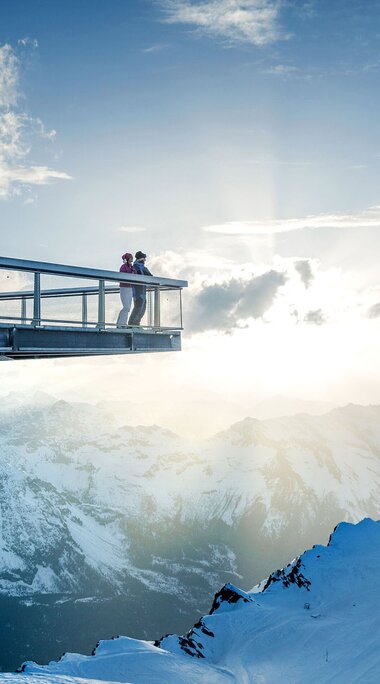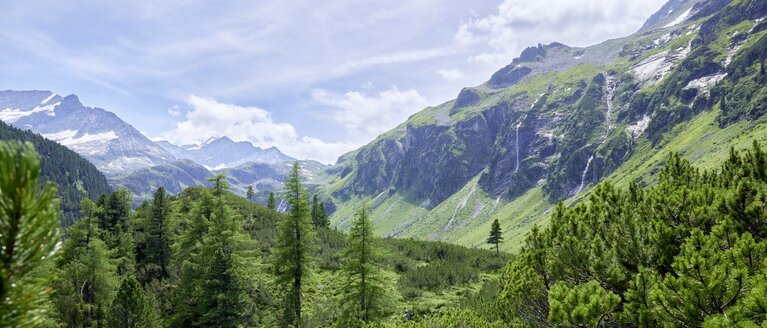Kaprunertal
Kaprun
Peaks and crossings
- Imbachhorn (2.470 m)
- Großes Wiesbachhorn (3.564 m)
- Klockerin (3.425)
- Mittlerer- (3.356 m) und
- Großer Bärenkopf (3.401 m)
- Hohe Riffl (3.338 m)
- Hocheiser (3.206 m)
- Grießkogel (3.066 m)
- Kitzsteinhorn (3.023 m)
- via Kapruner Törl (2.639 m) via Austriaweg to the Rudolfshütte or Stubachtal
- via Obere Bockkarscharte (Keilscharte) (3.187 m) to the Oberwalder Hütte
- via Bratschenkopfscharte (3.413 m) or
- via Gruberscharte (3.092 m) (Biwak) to the Schwarzenberghütte
Secrets of the gorge

Secrets of the gorge
South of the main step power station, the Bürgkogel locks the valley. The water of the Kapruner Ache river rushes and roars through the impressive Sigmund-Thun Klamm gorge. It is 300 m long, well developed and shows beautiful cauldron-shaped erosions in the blue-grey mica schist. The Bürgkogel itself has served as a human dwelling since around 1800 BC, later as a fortification for the Celts and then the Romans. Kaprun itself was mentioned in documents as early as 931 in the Codex Odalberti. Compared to some other Tauern valleys, the Kaprun Valley is poor in important minerals, but gold was still mined here in the Grubalpe area.
Moors, mosses and rustic forests
In front of the entrance to the valley, as a special natural history feature of the valley floor, lies a remarkable moorland, the Filzmoos - a silted up late glacial lake. The mixed deciduous forest by Kesselfalls is an ancient stand with harewood, common beech, elm, linden, ash and hazel plus the odd spruce. Such forests are rare in the Hohe Tauern. Many mosses and lichen thrive here as do various birds that inhabit the forest. Where the treeline begins, which is located at only around 1,800 m altitude for anthropogenic and partially climatic reasons (precipitation up to 3,000 mm per year), extensive dwarf-shrub heathland and alpine sedge and autumn moor grass as well as pioneer vegetation follow.
Between the poles of nature and economy
Kaprunertal valley is today characterised by reservoirs, power stations and power lines. The Schmiedingerkees glacial area at Kitzsteinhorn has been developed for tourism. Power stations and ski tourism are of great economic importance. The boundaries of the national park thus only begin far into the valley. Natural mountain lakes are rare in Kaprunertal. On the other hand, access to the 3,000- metre peaks of the Glockner Group and its fascinating glacial world is relatively easy thanks to the shortness of the valley and its infrastructure development. In the glacier forefield of Karlinger Kees, many different stages of colonisation by plants can be found in a small space. Next to bare spots we can find lichen lawn, cushion plant meadows and scrubs abundant in dwarf willow. This includes the Swiss willow, rare in Salzburg, which can be easily identified by its white-felty leaves. Wonderful glacial polishes and streams can be admired.
Alpine world: The Imbachhorn Peak
Past weathered green spruce the hike leads across alpine lawns along the ridge up to Imbachhorn, one of the most scenic panoramic mountains in the region.On the way we come across alpine plants and animals, such as edelweiss, gentian and alpine rose. The trail over the Brandlscharte to the lower terminus of the Kitzsteinhorn cable car should only be chosen in dry weather. It leads across grass heaths (arnica, bellflower...) down to grey alder and harewood. Bus connection back to Kaprun.
Walking time: Ascent from Kaprun approx. 6 hours, Descent approx. 3 hours (via Brandlscharte, only in dry weather) or 5 hours (via Neumayer Alm).
Iceworld: The glacier forefield of Kaprun - Karlinger Kees
Several distinctly highly distinct glaciers flow between Wiesbachhorn and Kapruner Törl in direction of Mooserboden. Ice booms, glacier snouts and many different trace of glacial activity can be observed at close range. From Mooserboden you walk along the dam walls of Moosersperre and Drossensperre reservoirs (2,045 m) and along Austriaweg no. 717 on the east banks of the Moosboden reservoir to its southern end. A hike across the Kapruner Törl into Stubachtal to Rudolfshütte can be done in a total of 5 hours.
Walking time: approx. 1½ hours for going up, Caution: danger of rockfalls!


